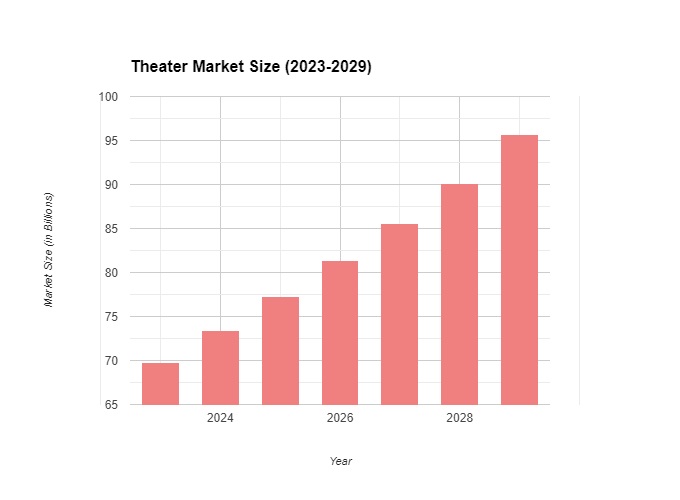The magic of the silver screen endures, and the theater market continues to captivate audiences globally. In 2024, the industry is not just surviving but thriving, navigating challenges and evolving with the times. Let’s take a deep dive into the current state of the theater market, examining its size, growth trajectory, notable trends, key players, and future outlook.
Market Size and Growth:
As of 2023, the theater market was valued at an impressive USD 69.78 billion. it is set to reach a staggering USD 95.66 billion in 2029, reflecting a robust compound annual growth rate (CAGR) of 5.24%. Despite the surge in home entertainment options, the theater market is evidently expanding.

Technological advancements, including 3D, 4DX, and IMAX, contribute significantly to this growth. These innovations provide audiences with a more immersive cinematic experience, attracting those seeking a break from the ordinary. Rising disposable income, particularly in developing regions, further fuels the growth, allowing audiences to indulge in leisure activities such as moviegoing. The popularity of blockbuster releases also plays a pivotal role, with audiences flocking to theaters to witness the grandeur of big-budget franchises.
Theater Market Trends:
The global theater industry is witnessing several trends that are shaping its future:
- Focus on Premium Experiences: Theaters are differentiating themselves by emphasizing premium formats such as luxury recliners, in-seat dining, and personalized services, offering a unique experience not easily replicated at home.
- Experiential Marketing: Creative marketing strategies are employed to generate excitement around films. Interactive events, themed concessions, and engaging social media campaigns are becoming integral to the moviegoing experience.
- Evolving Distribution Models: The traditional windowing system, where movies are exclusively released in theaters before hitting streaming platforms, is undergoing changes. Studios are experimenting with different release strategies, impacting traditional theater attendance.
Theater Market Players:
Key players dominate the theater market:
- AMC Entertainment Holdings, Inc.: The largest movie theater chain globally, boasting over 900 theaters across 11 countries.
- Cinemark Holdings, Inc.: A major player with a strong presence in the United States and Latin America.
- Comcast Corporation: Owner and operator of the Universal Pictures movie studio and various theater chains under the NBCUniversal umbrella.
- The Walt Disney Company: Operates Walt Disney Studios Motion Pictures and owns several theater chains, including Disney Theatres.
Theater Market Research Reports:
Understanding the theater market necessitates insights from research reports, providing:
- Market Size and Growth Forecasts: Offering a comprehensive snapshot of the current market state and predicting its trajectory.
- Consumer Trends: Identifying audience preferences and evolving behaviors, aiding businesses in adapting their offerings.
- Competitive Landscape: Analyzing the strengths and weaknesses of key players, enabling businesses to develop effective competitive strategies.
Prominent research firms publishing reports on the movie theater market. These reports are indispensable for investors, businesses, and stakeholders seeking a nuanced understanding of the theater market.
Theater Market Outlook:
While the theater market faces competition from streaming services, the allure of a unique social and immersive experience remains strong. With increasing disposable income, technological advancements, and strategic marketing initiatives, the industry is poised for continued growth. The ability to adapt to changing consumer preferences and distribution models will be crucial for the theater market’s long-term success. The flickering flame of the theater market continues to burn bright, promising a compelling future amid the evolving entertainment landscape.


